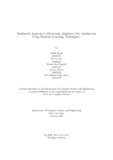Sentiment analysis to determine employee job satisfaction using machine learning techniques
Abstract
Over the past three years, the COVID-19 epidemic had a significant impact on
the labor market. Employees have been laid off and the majority of them have
changed careers. If they can collect more datasets in the future, the researchers will
be able to apply fine-tuning approaches to achieve perfect accuracy and precision.
Incorporating hybrid models such as optimization techniques, multi-modal models,
transfer learning models, hybrid deep learning models, sentiment models, etc. also
broadens the scope of this study. These models can employ a variety of learning
approaches, such as deep learning or traditional machine learning, and they can
use many different types of data, such as text, images, or audio. The corpus was
an additional strategy for improvement. These models consider lengthier texts in
addition. 10% of US workers who keep their existing jobs are dissatisfied with them.
Employee happiness is mostly influenced by business culture, but there are also cer tain economic and social elements that are interconnected. To ascertain the level of
employee satisfaction and associated factors, significant study has been conducted.
One of the most popular channels for opinion expression is social media. People
now discuss the advantages and disadvantages of their work on the US-based social
media site Glassdoor. For this study, total 1,56,428 data has been collected from
Glassdoor.First, the data is correctly pre-processed after collection. The under standing of employee work satisfaction is provided by user ratings. For the purpose
of making future predictions, the data was divided into binary class dataset and
multiclass dataset. Moreover, this data is subjected to machine learning algorithms
and deep learning algorithms. The best way to reach the ultimate conclusion is to
use Bi-GRU for binary class dataset which has an overall accuracy of 97% and Bert
model for multiclass dataset which has an accuracy of 95%.

